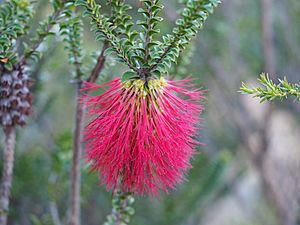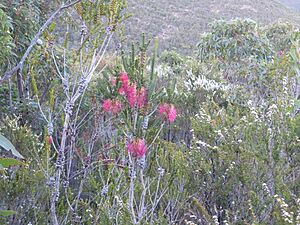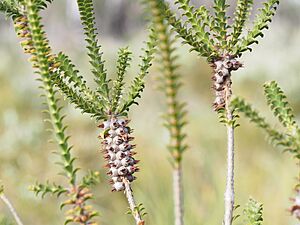Gravel bottlebrush facts for kids
Quick facts for kids Gravel bottlebrush |
|
|---|---|
 |
|
| B. decussata flowers | |
| Scientific classification | |
| Genus: |
Beaufortia (plant)
|
| Species: |
decussata
|
| Synonyms | |
|
Melaleuca transversa Craven & R.D.Edwards |
|
The Beaufortia decussata, often called gravel bottlebrush, is a special plant from the Myrtaceae family, which also includes myrtle trees. It grows only in the south-west part of Western Australia. This plant has long stems with branches mostly at the top. Its bright scarlet or orange-red flowers look like a bottlebrush and grow underneath these branches. People have described it as "a very splendid shrub" because of its beauty.
Contents
What the Gravel Bottlebrush Looks Like
The gravel bottlebrush is a plant that stands upright and can grow to about 3 meters (10 feet) tall. It doesn't have many branches.
Its leaves are arranged in a unique way. They grow in pairs that cross each other, forming four neat rows along the stems. Each leaf is shaped like an egg, with a pointed tip, and is about 10 millimeters (0.4 inches) long. You can usually see five small lines, or veins, on each leaf.
Flowers and Fruit
The flowers of the gravel bottlebrush are red to orange-red. They grow in clusters that are about 40 millimeters (1.6 inches) wide and 100 millimeters (4 inches) long. These clusters form a cylinder shape around the long stems, just below the branches.
Each flower has five small green parts called sepals, and five tiny petals. The most colorful parts are the five bundles of stamens, which are much longer than the petals. These stamens give the flowers their bright color.
You can see these beautiful flowers from August to December, or sometimes from January to April. After the flowers bloom, the plant produces fruit. These fruits are small, woody seed pods called capsules.

Plant Name and History
Beaufortia decussata was the very first type of Beaufortia plant to be officially named and described. A botanist named Robert Brown formally described it in 1812.
The second part of its scientific name, decussata, comes from a Latin word. It means "crossed like the letter X" or "like the Roman numeral ten". This name describes how the leaves are arranged in crossing pairs on the stem.
Where the Gravel Bottlebrush Grows
The gravel bottlebrush is found in specific natural areas of Western Australia. These areas include the Esperance Plains, Jarrah Forest, and Warren regions. It likes to grow in tall shrublands, which are areas with many shrubs. The plant prefers to grow in red, iron-rich soils that come from a type of rock called laterite.
Looking After the Plant
The Western Australian Government's Department of Parks and Wildlife has checked on the Beaufortia decussata. They have classified it as "not threatened". This means the plant is not currently in danger of disappearing.
Images for kids
-
Near Two Peoples Bay



